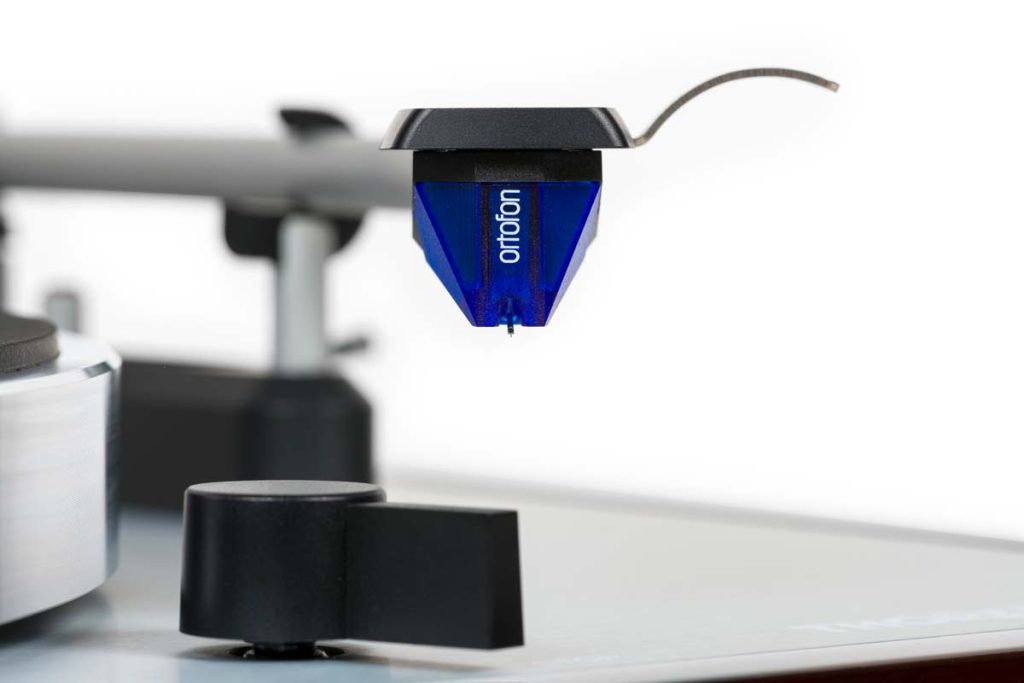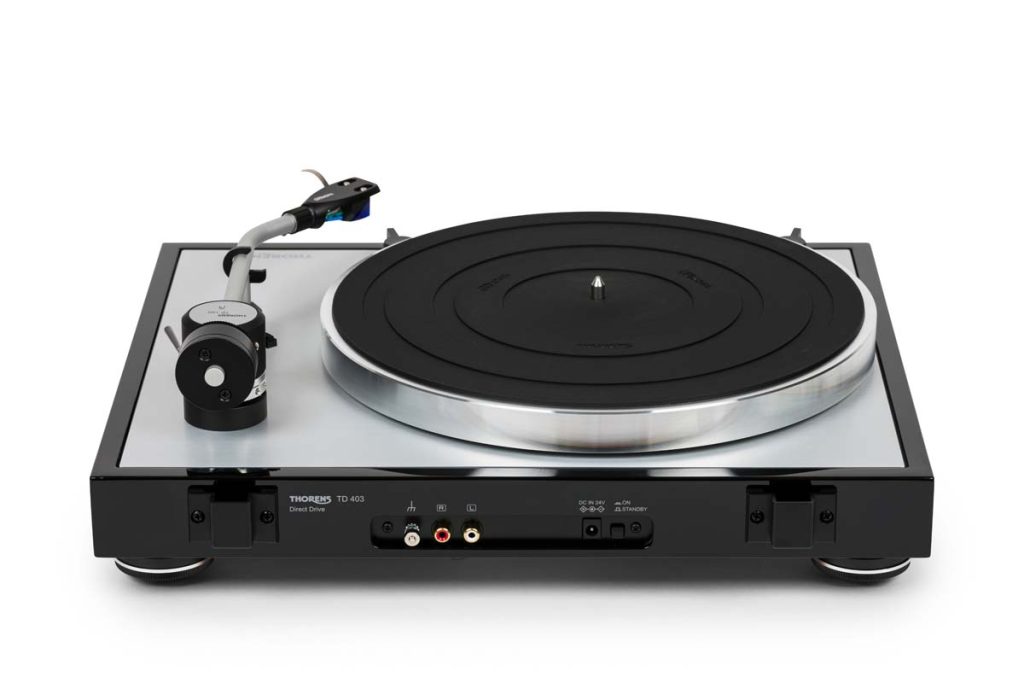Cold, wet, gray, dull … weekend. You don’t really know what to do with yourself. For breakfast, the public service channel explains the worldwide confusion with black humor and dark gray punchlines. Although this makes it easier to consume, it still doesn’t explain why the world is the way it is. You zap on to a news portal of your choice and realize: Everything is really circling the drain all around you. Even the weather is out of whack, it’s snowing like crazy now. At this time of year. Normally, I’d be cycling through the forest in a T-shirt about now, at least for the last few years. You can’t even rely on climate change anymore …
What you can rely on, though, are Thorens and Gunter Kürten. He has been running his brand on his own for a good four years now. During this time, the portfolio of the traditional brand has grown steadily in breadth and depth. Even though belt-driven turntables have always made up the majority of the equipment produced, one should not forget that Thorens is the inventor of the direct-drive turntable, not some Japanese tinkering shop.
While Matsushita (Technics) was still building bicycle lamps to pass the time until the first 12xx (1970) entered the scene, resourceful Swiss precision engineers in Sainte-Croix, near the French border, invented the first direct-drive gramophone with a spring mechanism. That was in 1928, followed almost thirty years later by the E53 PA, the world’s first electrically powered direct-driven turntable. In other words, at a time when the core competence of the Japanese was still located between refrigerators and bicycle tires. When the first turntable finally saw the strobe lights of this world in the land of the rising morning sun, Thorens had the dance floors of the republic firmly in its grip with the TD 524 as a professional grade direct-drive unit. Unfortunately, the Technics – being just ever-so-slightly ceaper at a quarter of the price of the Thorens – mysteriously caught on. The cooler pitch control may also have had an influence. Today, only techno paleontologists need this for occult rituals. Modern heroes of electronic dance music like Boris Brejcha know the term “record” only in connection with “festival” and “storage capacity”.
Back to the topic. Direct-drive turntables have slipped into the background during the vinyl hype of recent years. In my opinion, the directness and grip of a direct-drive turntable compared to a lightweight belt-driven turntable, regardless of whether it is integrated into the board or spring-mounted, has an appeal that should not be underestimated. My 1210 is currently equipped with a Nagaoka MP 500 in a modified Thorens headshell and regularly makes other test subjects pale in comparison. And me quite happy. Since a pitch control, while present if needed on the Technics, is pointless in everyday life, but high-quality workmanship, classic design and powerful sound are as necessary as coffee in the morning, a sleek thing like the Thorens would be a visually harmonious addition to the vintage NAD amplifier in my living room. The well-developed portfolio of Thorens offers three direct-drive solutions, with or without sub-chassis. The price scale within the range is finely gradated, so that from the pure casual user, who only likes to indulge in old records from time to time (TD 402 DD), up to the connoisseur with the highest demands on feel and sound (TD 124 DD), there should be the right turntable for every user.
For me, the Thorens TD 403 DD is the best value for money model in the Thorens range at just under 1400 Euros, I feel it is more than worth its price. Low-maintenance direct drive with sophisticated motor control, without subchassis, but with the TP 150 tonearm, cream of the fine mechanics in the chic of the seventies, which already left a more than positive impression in the TD 1500, which is to be classified again a class above the 403 DD. Delivered with pre-mounted MM cartridge Ortofon Blue, sturdy cover and – surprise, surprise – a sufficiently long as well as halfway trustworthy power supply. A set of signal cables including a separate ground wire is included, which guarantees hum-free contact between the RCA jacks of the TD 403 DD and the inputs on the NAD. Further points of contact with the outside world are the four – unfortunately not height-adjustable – plastic feet, whose soft material is supposed to have a dampening effect on microscopic interference. If you want to put a 403 DD in your living room, you don’t really have a choice. It is only available in high gloss, whether this reflects the light in black or reddish wood makes no difference in the result. The quality of the finish is absolutely flawless and underscores the reputation that a Thorens is always a touch fancier, a bit classier than the masses.
For the top, a sandwich of wood and an aluminum plate is used, its soft shimmer providing a charming contrast to the high-gloss look of the frame and drawing a stylistic bow to the retro chic of the tonearm. Even though the design of the arm, which is at the upper end of “medium” in terms of weight, takes cues from the design of the last century both haptically and visually, it is absolutely up to date in terms of precision mechanics. Thanks to extensive adjustment options, the TP 150 can be combined with just about any pickup, with the possible exception of ultra-light MCs with four-digit price tags. With the included steel pin, the tonearm height can be continuously adjusted via a fine thread. If, contrary to expectations, the azimuth needs to be corrected, the easiest way to adjust it is by loosening a small screw underneath the headshell. I would tend to leave the possibility of turning the azimuth at the base of the tonearm tube alone, since otherwise the cranking and vertical tracking angle would also change and the intended system will no longer be correctly adjusted.
Speaking of adjustment – you can safely forget about it. The cartridges are already perfectly mounted ex works, so the only thing left to do is to fix the headshell including the system to the tonearm tube by means of the SME lock and to adjust the contact force by means of the two-piece counterweight. I prefer to play the Ortofon Blue with a little more pressure on the groove than recommended. One or two Newton meters more contact force stabilizes the foundation without robbing energy from the mids, which are formidable for a “mid-range” system. Here, too, Gunter Kürten demonstrates a keen sense for which pickup harmonizes best with which model. Even with the Blue that comes included in the package price of 1400 euros, one gets along wonderfully for the first few years.
Fink’s Sunday Night Blues Club maintains a delightfully gnarly foundation with more knots than an old apple tree throughout the album’s length. “Little Bump” drags itself around the room like a wounded mammoth – if the heartbeat were to match the beat rate, there should be a defibrillator within reach. Bluesy blasts scatter somewhere between the record shelf and the wall. For so little sound, the Thorens pulls up quite a big stage. Is this the motor’s doing? Where every Technics sprints a good seven meters per second from a standstill, the Thorens TD 403 DD almost takes it easy. But one should not be deceived. The Thorens starts the turntable quite ponderously, but don’t worry: It’s just taking a run-up only to pull through powerfully afterwards. The fact that the motor has adequate torque becomes apparent while brushing the record. With a little pressure, you get most turntables to stop, while the Thorens stoically makes its rounds. So why the throttled start-up behavior? Developer Walter Fuchs cites significantly better rumble values, as the motor only gently plucks the platter rather than jerking it up to speed with brute force.
What can I say, the man is right. The Thorens has exactly the subtlety that I miss in my two Japanese drives. The Nakaoka MP 500, already not exactly a slouch in the two Technics, fertilizes the sarcasm in Georg Kreisler’s “Tauben vergiften im Park” with both arsenic and sunshine. Both Kreisler and his playing with piano and voice spread an unusual fresh élan. A first ray of sunshine on this hitherto so gray day, even if the weather continues to leave much to be desired. There remains some time for tinkering. Although the 403 is one hundred percent level ex works, my living room rack unfortunately is not. More out of necessity than anything else, three small cubes were cut from the leg of an old side table using a Japanese saw and then placed at the front corners and in the middle at the back. While I can’t explain it, it makes a clearly noticeable difference. “Hells Bells” from AC/DC’s Back In Black without the cubes is already an impressive thing, with cubes there’s significantly more space with significantly more bell in it. Kicks in the snare come on not with sneakers, but motorcycle boots, and Angus Young mills his guitar through my brain windings with prepubescent verve.
So, slowly but surely, I should think about sending the Thorens TD 403 DD back. It fits so well musically into my living room setup that I’m starting to think about how the mahogany cube would do as a permanent guest. Whenever I’m overcome with tinkering and tweaking mania, my gear acquisition impulse throws its hands up in horror. After all, there are already four turntables sharing floor space in my home. But there’s still one thing I need to try: Rap, dirty rap. Politically absolutely not correct, about as chart compatible as overtone songs even back then, but with such a straight production quality that Dr. Dre must have spit out his pacifier when Daddy played the disc. The 403 puts the bone-dry beat on such a grippy foundation that even the Transrotor in the other room turns a little pale. The vocals sound like peeled, naked, direct, not a shred of fat on the vocal chords. With 90s rap, the Thorens shows one of five fingers to its Japanese colleagues rather disrespectfully and relegates the two classics to their place as decorative pieces.
With the TD 403 DD, Thorens mastermind Gunter Kürten and his developers have once again succeeded in creating a package that plays on par even in a direct comparison with considerably more expensive turntables. Thanks to a maintenance-free drive, flawless finish and timeless design, it’s hard to complain about anything here if you’re seriously interested in vinyl.
Accompanying Equipment
Turntables: Transrotor Max Nero, Acoustic Solid Vintage, Technics SL-1210 MK2, Technics SL-1710 | Cartridges: Clearaudio Charisma V2, Ortofon Quintet Bronze, Nagaoka MP 500, Ortofon Nightclub, Transrotor Merlo | Phono preamp: Acoustic Solid Phono preamp | Integrated amplifier: Einstein The Tune, NAD C320 | D/A Converter: Audiolab M-DAC Mini | Power Amplifier: Lehmannaudio Black Cube Stamp | Loudspeakers: Heco Belladonna, Sonoro Grand Orchestra, Sonoro Orchestra Slim, Audio Physic Seemon | Cables: German Highend, AudioQuest, T+A, Horn Audiophiles, in-akustik, Isotek
Turntable Thorens TD 403 DD
Concept: manual turntable with direct drive | Drive: electronically controlled DC motor | Platter: 22 mm aluminum platter | Speed: 33 1/3 or 45 rpm | Tonearm: Thorens TP 150 with SME headshell | Connectors: 1 x stereo RCA | Finishes: Black or Walnut high gloss | Dimensions (W/H/D): 42/14/36 cm | Weight: 7 kg | Warranty: 2 years | Price: around 1400 € (incl. Ortofon 2M Blue cartridge)
Thorens
Lustheide 85
51427 Bergisch Gladbach
Phone +49 2204 8677720











